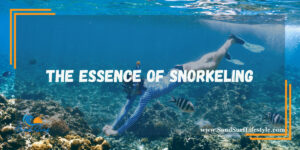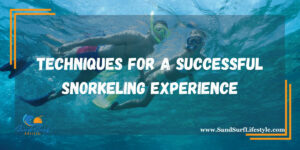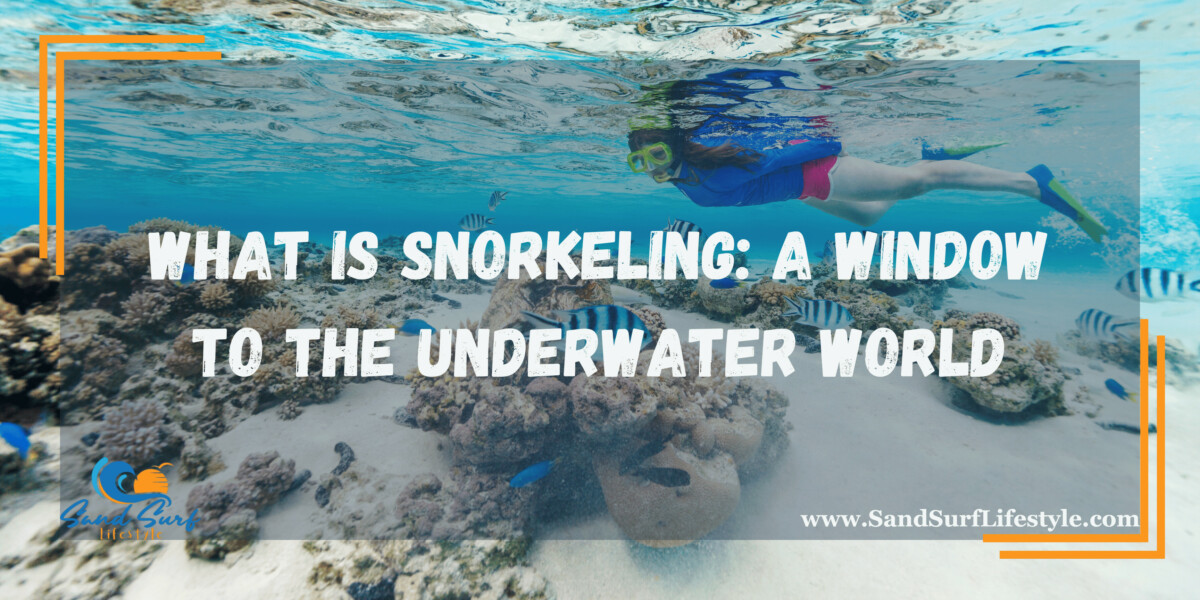Snorkeling, a popular aquatic activity, beckons adventurers to explore the captivating mysteries of the underwater world. It offers a unique blend of relaxation and adventure, making it an ideal pursuit for those who want to immerse themselves in the beauty of the oceans, lakes, and rivers.
I. The Essence of Snorkeling

At its core, snorkeling is a water-based activity that epitomizes the marriage of human curiosity and the enigmatic depths of the underwater world. Participants embark on an adventure by floating effortlessly on the water’s surface while harnessing the power of a snorkel and mask to breathe with ease beneath the waves. The allure of snorkeling lies in its accessibility; it beckons individuals of diverse skill levels and ages to partake in a mesmerizing aquatic journey. Unlike scuba diving, which often demands extensive training and cumbersome equipment, snorkeling presents itself as an inviting portal to the mysteries below.
In the embrace of snorkeling, one becomes an observer of a vibrant, submerged universe. It unveils fleeting encounters with marine life, from the elegant dance of colorful fish to the intricate architecture of coral reefs. As you descend into this liquid realm, you’re greeted by the harmony of underwater formations, where nature’s artistry and evolution converge. Whether you’re a novice or a seasoned snorkeler, the experience is one of awe, wonder, and reverence for the world beneath the waves.
To discover the best snorkel sets, check out this article.
II. A Brief History of Snorkeling
The origins of snorkeling are a testament to humanity’s enduring fascination with the sea. Stretching back millennia, various ancient civilizations displayed early inklings of snorkeling ingenuity. The Greeks, Romans, and indigenous peoples of the South Pacific are among the notable pioneers who devised rudimentary snorkel-like contrivances.
These early snorkels, fashioned from hollow reeds, bamboo, or animal skins, served a common purpose: to facilitate underwater breathing while maintaining proximity to the surface. These humble inventions, though primitive by today’s standards, laid the foundation for the snorkeling practices we cherish today.
The very term “snorkel” traces its etymology to the German word “schnorchel,” evoking images of a breathing tube employed by German submarine crews during World War II. This nautical innovation allowed submerged submarines to draw in vital air while staying hidden beneath the waves. Yet, it was the post-war years, marked by innovations in mask and snorkel design, that ushered in the golden age of snorkeling as a recreational pursuit. With accessible equipment and the spirit of exploration, snorkeling emerged from history’s depths to become a beloved pastime, inviting enthusiasts to venture into the world’s oceans and embrace their inner aquatic explorers.
III. Essential Gear for Snorkeling
A successful snorkeling adventure hinges on having the right equipment. Here are the essential items you’ll need:
Mask
A high-quality snorkeling mask is your portal to the underwater realm. It forms an airtight seal around your eyes, creating a vital barrier between your face and the water. This seal ensures that water stays out, granting you a crystal-clear view of the aquatic world below. When selecting a mask, prioritize comfort and fit; a well-fitted mask enhances the overall snorkeling experience. Furthermore, opt for anti-fog coatings or solutions to prevent the lens from clouding, guaranteeing uninterrupted visibility throughout your adventure.
Snorkel
The snorkel is your lifeline beneath the waves, allowing you to breathe effortlessly without the need to resurface constantly. A comfortable mouthpiece is essential for extended snorkeling sessions, ensuring ease of use and reduced jaw fatigue. Look for a snorkel equipped with a purge valve—a valuable feature that expels any water that might enter the snorkel, preventing the disruption of your breathing and enhancing safety while submerged.
Fins
Fins are your aquatic wings, providing the necessary propulsion to glide gracefully through the water. They amplify your movements, allowing for efficient navigation and conservation of energy. There is a wide variety of fins available, ranging from full-foot designs to those with adjustable straps. The choice depends on your comfort, swimming style, and the specific conditions of your snorkeling adventure. Properly selected fins contribute to a more enjoyable and effortless exploration of the underwater world.
Wetsuit or Rash Guard
The choice between a wetsuit or rash guard depends on the water’s temperature and your personal preferences. In cooler waters, a wetsuit provides thermal insulation, keeping your body warm and comfortable during extended snorkeling sessions. Additionally, it offers protection against sunburn and potential stings or scratches from marine life. For warmer waters, a lightweight rash guard provides sun protection and minimizes skin irritation while maintaining flexibility for unrestricted movement.
Flotation Devices
While snorkeling is generally user-friendly, safety should always be a priority. Carrying a flotation device, such as a buoyancy vest or life jacket, offers an additional layer of security, especially for less experienced swimmers. These devices provide buoyancy and peace of mind, ensuring you can stay afloat effortlessly in case of fatigue or unexpected conditions. Always choose a flotation device that suits your comfort level and provides adequate support for your snorkeling adventures.
IV. Techniques for a Successful Snorkeling Experience

Once you have the necessary gear, it’s time to hit the water. Here are some techniques and tips to ensure a memorable and safe snorkeling experience:
Breathing
Learning to breathe through the snorkel is fundamental to a successful and enjoyable snorkeling experience. Practice in shallow, calm waters until you feel completely at ease. Focus on slow, deep breaths, allowing the snorkel to do its job efficiently. Remember that the snorkel is your conduit to the surface, so breathe steadily and rhythmically. With practice, breathing underwater becomes second nature, enabling you to savor the underwater wonders without interruption.
Floating
Achieving a state of relaxation and horizontal buoyancy is paramount for an effortless snorkeling excursion. Keep your body calm, your limbs relaxed, and your position parallel to the water’s surface. Allow your fins to provide gentle propulsion to maintain your position and direction. Avoid excessive, forceful kicking, as it can stir up sediment and disturb the tranquil underwater environment. By floating serenely, you become an unobtrusive observer, blending harmoniously with the aquatic world.
Mask Clearing
Encountering a foggy or water-filled mask can be disconcerting, but with the right technique, it’s easily resolved. Should water breach your mask, resist the urge to panic. Tilt your head slightly upward, pressing the upper part of the mask firmly against your face. Then, exhale slowly through your nose. This controlled exhalation forces the water out through the bottom of the mask, restoring clarity to your underwater view. Mastery of this skill ensures uninterrupted exploration, allowing you to navigate the depths confidently.
Equalization
When venturing below the water’s surface, it’s essential to equalize the pressure in your ears to prevent discomfort or injury. To achieve this, pinch your nostrils shut with your fingers and blow gently as if trying to force air through your closed nose. This equalizes the pressure in your ears with the surrounding water pressure, ensuring a comfortable descent. Regular equalization during underwater exploration keeps your ears free from discomfort and allows you to enjoy the submerged world without distraction.
Marine Life Etiquette
Respect for the marine environment and its inhabitants is paramount in snorkeling. Approach encounters with underwater creatures with mindfulness and awe. Maintain a safe distance from marine life, refraining from touching or disturbing them. Avoid chasing or pursuing animals, as this can cause stress or harm to them. Instead, observe these fascinating beings from a respectful vantage point, letting them go about their natural activities undisturbed. By adhering to these principles of marine life etiquette, you become a conscientious steward of the underwater world, preserving its beauty for generations to come.
V. Snorkeling Destinations Around the World
The world is dotted with breathtaking snorkeling destinations that cater to diverse interests and skill levels. Here are a few remarkable spots to consider:
Great Barrier Reef, Australia
The Great Barrier Reef, often dubbed the world’s largest living structure, is a true masterpiece of nature. Stretching over 2,300 kilometers along the northeastern coast of Australia, it showcases a vibrant underwater world that is nothing short of awe-inspiring. The reef is renowned for its kaleidoscope of marine life, featuring an array of colorful fish, coral formations, and aquatic flora. Snorkelers here are treated to an unparalleled spectacle, swimming alongside species like clownfish, giant clams, and sea turtles. The sheer scale and biodiversity of the Great Barrier Reef make it a bucket-list destination for snorkeling enthusiasts seeking to explore one of Earth’s most remarkable ecosystems.
Maui, Hawaii
Maui, an island paradise in Hawaii, boasts crystal-clear waters that beckon snorkelers from around the world. Two standout snorkeling sites, the Molokini Crater and Honolua Bay, epitomize the island’s aquatic splendor. The Molokini Crater, a partially submerged volcanic crater, offers a surreal underwater landscape teeming with marine life. Meanwhile, Honolua Bay showcases pristine coral gardens and an abundance of tropical fish. Maui’s snorkeling scene is a testament to the island’s natural beauty, making it an idyllic destination for those seeking tranquil and immersive underwater experiences.
Belize Barrier Reef
Designated as a UNESCO World Heritage site, the Belize Barrier Reef is a crown jewel among Caribbean snorkeling destinations. Its crystal-clear waters are home to a vibrant community of marine creatures, including colorful fish, graceful rays, and gentle nurse sharks. The reef’s intricate coral formations add to its allure, creating a breathtaking backdrop for snorkelers to explore. Whether you’re gliding over the reef’s shallow waters or venturing into deeper realms, Belize’s barrier reef promises an enchanting journey through an underwater paradise that captivates both novice and experienced snorkelers alike.
Red Sea, Egypt
Egypt’s Red Sea, a mecca for underwater enthusiasts, boasts warm, clear waters and an abundance of marine life that ranks it among the world’s top snorkeling destinations. The Red Sea is celebrated for its thriving coral reefs, offering a kaleidoscope of colors and shapes. Beneath the surface, snorkelers encounter a diverse cast of characters, from graceful dolphins to schools of exotic fish. The Red Sea’s unique blend of natural beauty and historical intrigue, with submerged shipwrecks to explore, creates an irresistible draw for snorkelers and divers seeking adventure and serenity.
Palau, Micronesia
Palau, nestled in the western Pacific Ocean, boasts a truly exceptional snorkeling experience at its world-famous Jellyfish Lake. This ethereal locale allows snorkelers to swim amongst thousands of harmless jellyfish that have evolved in isolation over centuries. As you glide through the calm, brackish waters, you’re enveloped by a mesmerizing dance of pulsating jellyfish, creating an otherworldly sensation. Palau offers not only this unique encounter but also a treasure trove of marine biodiversity, with vibrant coral gardens and diverse marine life to explore, making it a must-visit destination for snorkelers seeking unforgettable encounters with the natural world.
VI. Environmental Conservation in Snorkeling
As snorkeling becomes increasingly popular, it’s crucial to prioritize environmental conservation. Here are some ways to do your part:
Choose Responsible Operators
When selecting snorkeling tours, it’s imperative to choose operators committed to responsible and sustainable practices. These ethical operators prioritize minimizing their impact on fragile marine ecosystems. They employ strategies such as using eco-friendly mooring systems to reduce anchor damage and educating visitors about the importance of marine conservation. Opting for such operators ensures that your snorkeling experience aligns with a commitment to preserving the natural beauty and integrity of the underwater world, leaving a positive and lasting impact on the environment.
Avoid Touching Coral
Coral reefs are delicate and vulnerable ecosystems, and even minor contact can cause irreparable harm. To safeguard these underwater wonders, it’s crucial to maintain a safe distance and exercise caution with your fins. Be mindful of your surroundings to prevent accidental contact with coral formations. By respecting these living structures and giving them the space they need to thrive, you contribute to the preservation of these vital habitats and the myriad of species that call them home.
Dispose of Trash Properly
Litter in the ocean poses a severe threat to marine life and ecosystems. It is vital to adopt a strict “leave no trace” policy while snorkeling. Ensure all your belongings are secure and never dispose of trash in the water. Use designated receptacles on boats or back on land to dispose of waste properly. This responsible behavior not only maintains the pristine beauty of snorkeling sites but also prevents harm to marine creatures that may ingest or become entangled in debris. Your actions can make a significant difference in protecting the ocean environment.
Use Reef-Friendly Sunscreen
The chemicals found in many conventional sunscreens can have detrimental effects on coral reefs, causing coral bleaching and negatively impacting marine life. To safeguard these fragile ecosystems, opt for reef-friendly sunscreens that use ingredients less harmful to marine environments. By choosing these sunscreens, you protect your skin from harmful UV rays without contributing to the degradation of coral reefs. Your conscious choice promotes both personal well-being and the preservation of underwater ecosystems, aligning with responsible snorkeling practices that prioritize the health of our oceans.
To discover the snorkeling world’s most pristine locations, check out this article.
Conclusion
Snorkeling offers a gateway to the wonders of the underwater world. It’s a journey of discovery, a chance to witness the vibrant ecosystems beneath the surface, and a reminder of the importance of preserving these precious environments for generations to come. So, gear up, take a deep breath, dive into the adventure that is snorkeling, and let the mysteries of the deep captivate your soul.
Please note that the contents of this blog are for informational and entertainment purposes only and should not be construed as legal advice. Any action taken based on the information provided in this blog is solely at your own risk. Additionally, all images used in this blog are generated under the CC0 license of Creative Commons, which means they are free to use for any purpose without attribution.

